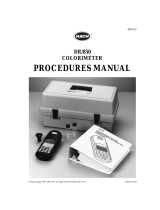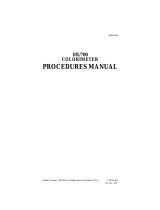Page is loading ...

Zinc 3
Range(s): 0-3.00 ppm Zn
Colorimeter Series
Instruction #5182
Procedure
Interferences
Note: Zinc coprecipitated with insoluble metal hydroxides
or metal oxides (i.e., iron oxide) will not be measured.
Note: Combined concentration of Cu
2+
, Ni
2+
, and Zn
2+
must
not exceed 6 ppm.
Aluminum ≥ 3 ppm – negative interference
Cadmium ≥ 4 ppm – negative interference
Copper ≥ 4 ppm – negative interference
EDTA, all levels – negative interference
Hardness, Calcium (CaCO
3
) ≥ 1000 ppm – positive interference
Iron, Ferric ≥ 3 ppm – negative interference
Iron, Ferrous ≥ 3 ppm – negative interference
Manganese ≥ 2 ppm – negative interference
Nickel ≥ 3 ppm – negative interference
NTA, all levels – negative interference
Phosphonate (ATMP) ≥ 1 ppm – negative interference
Phosphonate (DTPMP) ≥ 40 ppm – negative interference
Phosphonate (HEDP) ≥ 40 ppm – negative interference
The following analytes were tested to the levels listed and
found not to cause any interference up to the specified
values:
Alkalinity, Total (CaCO
3
) – 500 ppm
Chlorine – 10 ppm
Chromate – 10 ppm
Molybdate – 10 ppm
Nitrite – 2000 ppm
Phosphate – 20 ppm
Phosphonate (K
6
HDTMP) – 80 ppm
Phosphonate (PBTC) – 80 ppm
Polymer – 20 ppm
Polyphosphate – 6 ppm
1. Turn on the Colorimeter.
2. Select a test menu (ALL TESTS, RECENT TESTS, or
FAVORITES) containing Zinc 3 using .
3. Select Zinc 3 using ; then press ENTER .
4. Rinse and fill 25 mm sample cell to 10 mL mark with
sample.
5. Add 1 mL Zinc 3 - Reagent A; then swirl to mix.
6. Using the 0.15 g dipper spoon, add 2 level dippers
Zinc 3 - Reagent B; then cap and invert to mix.
7. Remove cap and add 1 mL Zinc 3 - Reagent C; then
cap and swirl to mix thoroughly.
8. Insert sample cell into sample cell compartment. Align
marks per User’s Manual.
9. Select ZERO using ; then press ENTER . Zero
will be displayed.
10. Remove sample cell from sample cell compartment;
then remove cap.
11. Add 6 drops Zinc 3 - Reagent D; then cap and swirl to
mix thoroughly.
12. Insert sample cell into sample cell compartment. Align
marks.
13. Select READ using ; then press ENTER . The
instrument will read the sample and the result will be
displayed.
(over)
Test Method
Zincon
Under basic conditions, zinc reacts with zincon to produce a blue-colored complex that is proportional to the zinc concentration in a sample.

Application
Ordering Info
01/13
Industrial Water
Reagent Pack
K-8019 Zinc 3
Formulated for exclusive use with Taylor’s TTi
®
Colorimeter.
Reagent Pack Components
R-8019A Zinc 3 - Reagent A
R-8019B Zinc 3 - Reagent B
R-8019C Zinc 3 - Reagent C
R-8019D Zinc 3 - Reagent D
31 Loveton Circle, Sparks, MD 21152 U.S.A.
800-TEST KIT (837-8548) • 410-472-4340
Instruction #5182
0.04 ppm Zn
Estimated
Detection Limit
Precision
Using two lots of reagent and a standard solution of 2.00 ppm Zn, an individual analyst obtained a standard deviation with the instrument of ± 0.04 ppm Zn.
/


